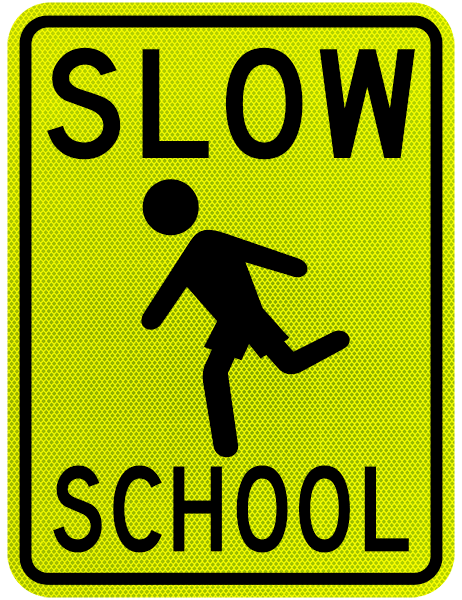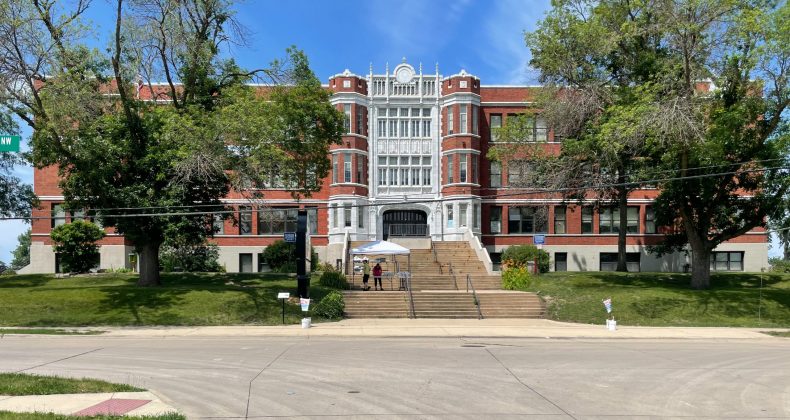 |
| Source: Wikimedia commons |
For a second year, my Corridor Urbanism co-founder Ben Kaplan and I took the urbanist message to America's youth, specifically sixth graders from Roosevelt and Wilson Middle Schools in Cedar Rapids participating in the Kids on Course program at Coe College. Last time we asked them about changes they'd like to see in the Mound View neighborhood--I'm not sure we knew then that none of them lives near the Mound View neighborhood--resulting in a gaudy but nonetheless energetic list of walkable potential attractions.
This year we asked them about mobility, specifically how confident these 12-year-olds feel navigating the city on their own, and what changes to street design might encourage them. (Ben introduced us to Streetmix, an intriguing website on which you can design your own street features. They drew their own ideal streets, which were adorable and which I would be able to share with you except that I didn't think to collect them. They did tend to feature protected bike lanes, whether because we unconsciously suggested them or not.
What we did collect were surveys we used to start them thinking about the subject. We had five students, which perhaps reflects that the compelling nature of urban design has not yet caught fire among our city's 12-year-olds. Three were from Wilson, two from Roosevelt. There were four boys and one girl, all white except for one boy who came to the U.S. from Congo. Your humble blogger can tell you that, at 12, he took the design of his town for granted, just the way it was, and assumes that these young people have, too--that is, until they landed in a classroom with certain troublemakers who attempted to teach them to think critically about their streets!
 |
| (Source: Roosevelt school website) |
Roosevelt (above, recently renamed Roosevelt Creative Corridor Business Academy) and Wilson were built in the 1920s and serve the near west side of the city. Their attendance areas are fairly compact for Cedar Rapids middle schools, and are a mix of older neighborhoods with grid street patterns and some newer subdivisions with cul-de-sacs. We didn't ask about students' neighborhoods or specific distance from school.
(1) How do you usually travel to school? Bus-1 Car-2 Walk-1 Car or Walk-1
(2) Do you ride a bicycle for fun? To get places? Both? Fun-2 Both-1 Yes-1 Not really-1
(3) Can/do you walk or ride your bike to school? Why or why not?
Walk, because my mom don't want my bike stolen or broken!
I can walk to school but not ride my bike there because it is [too hilly?]
I walk
No, because it's to far and my parents wont let me
No, I live far from Wilson
(4) Can/do you walk or ride your bike to your friend's house?
Yes, I walk because we live 3 houses down from each other
Yes, both
I walk
I can if I know where they live
No
(5) Could you run an errand to the store for your family, if they asked?
Yes-2
No-2 [One added: "I cant run a errand to a store because they are too far away"]
I don't know
(6) Would you ride the city bus by yourself?
Yes-2 [One added: "it sounds like fun"]
No-2
I do not no
(7) Is there a place you like to go in town where you have to rely on others to take you?
Lindale Mall
Practice, restaurant, shop
No or "not relly"-3
(8) If your town could change one thing to make it easier for you to get around on your own, what should it be?
More rules
A train
Yes
Nothing
I do not no
What do we learn from this tiny lot of surveys, other than spelling may be a lost art and/or that I am either easily amused or patronizing? First of all, none of the children shared our experience of independent movement at that age. Ben (in the 1990s, in Albuquerque, New Mexico) and I (in the 1970s, in Wheaton, Illinois) both remember spending our summers riding our bikes all over the place. They do not do this. Secondly, though this was probably the first time they thought much about city design, they are very aware of this limitation.
Nearly two decades ago, Andres Duany and his co-authors described how suburban design negatively impacts children:
Dependent always on some adult to drive them around, children and adolescents are unable to practice at becoming adults. They cannot run so simple a household errand as picking up a carton of milk. They cannot bicycle to the toy store and spend their money on their own. They cannot drop in on their mother at work. Most cannot walk to school. Even pickup baseball games are a thing of the past, with parents now required to arrange car-pooling with near-military precision, to transport the children at the appointed times. Children are frozen in a form of infancy, utterly dependent on others, bereft of the ability to introduce variety into their own lives, robbed of the opportunity to make choices and exercise judgment. (Andres Duany, Elizabeth Plater-Zyberk, and Jeff Speck, Suburban Nation: The Rise of Sprawl and the Decline of the American Dream [New York: North Point Press, 10th anniversary edition, 2010], 116-117)There is also the question of enabling routine activity to improve physical fitness.
Despite Cedar Rapids's efforts to improve the walkability of downtown and the core neighborhoods, more consideration of the development pattern of the town as a whole is needed to equitably address the "8-80" crowd, i.e. children and the elderly. Note that the students' comments reflected concern primarily with distance to places, and secondarily to secure storage, moreso than street infrastructure. Where do we build schools? Housing developments? Shopping areas?
Finally, who knows why Ben and I are so nerdy about urban development? But surely one factor for both of us was that we learned from a young age that our mobility was not dependent on driving or being driven in cars. Though both of us are now auto-owners, we continue to use a variety of transportation modes to get around our city, and look for ways that our city can better accommodate everyone.
Today's independent walkers and bike riders will be better prepared for the needs of the 21st century.
SEE ALSO: Spencer Gardner, "Strength Test #6: Can Children Safely Walk or Bike in Your Town?" Strong Towns, 5 April 2017
ON THIS BLOG:
"Talking About Walking," 4 November 2013
"What is a Stroad?" 3 April 2014





